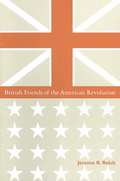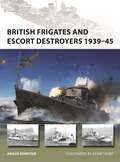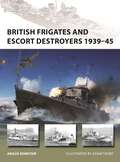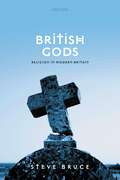- Table View
- List View
British Friends of the American Revolution
by Jerome R. ReichThis volume profiles a dozen British men and women, who, for varying reasons, opposed the policy of the British government towards its 13 colonies before and during the American Revolution. Their actions helped prepare the way for the recognition of the United States as an independent nation.
British Friends of the American Revolution
by Jerome R. ReichThis volume profiles a dozen British men and women, who, for varying reasons, opposed the policy of the British government towards its 13 colonies before and during the American Revolution. Their actions helped prepare the way for the recognition of the United States as an independent nation.
British Frigate vs French Frigate: 1793–1814 (Duel)
by Peter Dennis Mark LardasIn the Age of Fighting Sail (1650–1820), ambitious officers of the navies of many nations sought command of a frigate. Speedy, nimble and formidably armed, frigates often operated independently, unlike the larger ships of the line. Legendary sailors such as Edward Pellew and Charles-Alexandre Léon Durand, Comte de Linoise, found that commanding such a ship offered numerous opportunities for wealth. In this book, four representative frigate duels are examined: first, a battle fought between two closely matched ships (HMS Nymphe (36) vs La Cléopâtre (32); second, a victory won by an inferior British frigate over a superior French frigate (HMS Pallas (32) vs Minerve (40); third, a victory – the only one – by an inferior French frigate over a superior British frigate (HMS Ambuscade (32) vs Baïonnaise (24), and fourth, victory of a superior British frigate over an inferior French frigate (HMS Indefatigable (44) of Hornblower fame vs La Virginie (40). Featuring specially commissioned artwork and offering expert analysis, this study provides a vivid account of the bloody combats fought by the most romantic warship of the Revolutionary and Napoleonic era – the frigate.
British Frigate vs French Frigate: 1793–1814 (Duel)
by Peter Dennis Mark LardasIn the Age of Fighting Sail (1650–1820), ambitious officers of the navies of many nations sought command of a frigate. Speedy, nimble and formidably armed, frigates often operated independently, unlike the larger ships of the line. Legendary sailors such as Edward Pellew and Charles-Alexandre Léon Durand, Comte de Linoise, found that commanding such a ship offered numerous opportunities for wealth. In this book, four representative frigate duels are examined: first, a battle fought between two closely matched ships (HMS Nymphe (36) vs La Cléopâtre (32); second, a victory won by an inferior British frigate over a superior French frigate (HMS Pallas (32) vs Minerve (40); third, a victory – the only one – by an inferior French frigate over a superior British frigate (HMS Ambuscade (32) vs Baïonnaise (24), and fourth, victory of a superior British frigate over an inferior French frigate (HMS Indefatigable (44) of Hornblower fame vs La Virginie (40). Featuring specially commissioned artwork and offering expert analysis, this study provides a vivid account of the bloody combats fought by the most romantic warship of the Revolutionary and Napoleonic era – the frigate.
British Frigates and Escort Destroyers 1939–45 (New Vanguard)
by Angus KonstamA history of the small, mass-produced warships that defended the Atlantic convoys from U-boats and secured Britain's lifeline to the United States.As the Battle of the Atlantic grew fiercer, Britain and the Commonwealth needed large quantities of new warships to defend their shipping which could be produced cheaply. The two largest type of ship produced were the escort destroyer and the frigate. Escort destroyers were essentially small destroyers optimized for anti-submarine warfare, with speed and anti-surface weaponry sacrificed, while frigates were simpler, designed so they could be built quickly in civilian shipyards. Nearly 200 were built.These warships were key to protecting convoys in the Atlantic Ocean where their range and seagoing qualities made them well-suited for operations. They were also used to form hunting groups, and collectively accounted for the destruction of scores of German U-boats. Their arrival came at a critical time for the Royal Navy, when the Battle of the Atlantic was reaching its climax, and losses among both merchant ships and escorts were mounting. In this book, naval expert Angus Konstam outlines the history of the Hunt-, Loch-, Bay-, and River-class escort destroyers and frigates, revealing how crews fought, and what life was like on board. Using archive photos, detailed colour profiles, a Hunt-class cutaway, and battlescenes of the ships at war, he explores the key role played by these small but deadly escorts.
British Frigates and Escort Destroyers 1939–45 (New Vanguard)
by Angus KonstamA history of the small, mass-produced warships that defended the Atlantic convoys from U-boats and secured Britain's lifeline to the United States.As the Battle of the Atlantic grew fiercer, Britain and the Commonwealth needed large quantities of new warships to defend their shipping which could be produced cheaply. The two largest type of ship produced were the escort destroyer and the frigate. Escort destroyers were essentially small destroyers optimized for anti-submarine warfare, with speed and anti-surface weaponry sacrificed, while frigates were simpler, designed so they could be built quickly in civilian shipyards. Nearly 200 were built.These warships were key to protecting convoys in the Atlantic Ocean where their range and seagoing qualities made them well-suited for operations. They were also used to form hunting groups, and collectively accounted for the destruction of scores of German U-boats. Their arrival came at a critical time for the Royal Navy, when the Battle of the Atlantic was reaching its climax, and losses among both merchant ships and escorts were mounting. In this book, naval expert Angus Konstam outlines the history of the Hunt-, Loch-, Bay-, and River-class escort destroyers and frigates, revealing how crews fought, and what life was like on board. Using archive photos, detailed colour profiles, a Hunt-class cutaway, and battlescenes of the ships at war, he explores the key role played by these small but deadly escorts.
British Gallantry Awards 1855-2000 (Shire Library)
by Peter DuckersThis book surveys the British decorations and medals from the origins in the Crimean War of 1854-6 up to the end of the twentieth century.
The British General Election of 1970 (The\british General Elections 1945-92 Ser.)
by David Butler Michael Pinto-DuschinskyThe British General Election of 2015
by Dennis Kavanagh Philip CowleyThe British General Election of 2015 is a must-read for anyone wanting to know how the action unfolded in the most unpredictable election for a generation. Drawing on hundreds of confidential interviews with all the key players, it offers a compelling insider's guide to the election's background, campaign, and the results which led to the formation of the first majority Conservative government in eighteen years. Designed to appeal to everyone from Westminster insiders, politics students and the wider general public, this is the authoritative account of the 2015 election. Continuing a proud Palgrave Macmillan tradition, The British General Election of 2015 is the 19th edition and celebrates the 70th year of this prestigious series.
British General Election of October, 1974 (The\british General Elections 1945-92 Ser.)
by David Butler Dennis KavanaghBritish General Elections Since 1964: Diversity, Dealignment, And Disillusion
by David Denver Mark GarnettDespite a recent decline in voter turnout, British general elections are still the centrepiece of Britain's liberal democracy and their results make a real difference to every British citizen. They command strong media interest long before their dates are announced and even uneventful campaigns dominate the headlines. The 2010 general election saw the first direct televised debates between the main party leaders, adding further interest to a battle which was always likely to be close. The result was a 'hung parliament' and the first British coalition government since 1945. However, as this book shows these were only the latest manifestations of a transformation in British elections which began in the early 1960s. While some election rituals remain intact - the counting of votes by hand, the solemn declaration of individual constituency results and, most importantly, the peaceful handover of power if the incumbent party loses, almost everything of significance has changed. Voters have very different attitudes; fewer of them have party loyalties which are more than skin deep, and they tend to base their choices on 'short-term' factors such as the perceived competence of the parties and the image of the leader. The parties themselves are barely recognisable from the institutions of 1964 - not least because their membership figures have dwindled dramatically. Election campaigns are now heavily centralised, and focus obsessively on a handful of target seats. This book reviews the history of British general elections since 1964, charting the changes in voters and parties at every step. In parallel, it shows how electoral analysts have responded to these developments. The first book of its kind, it will be invaluable to readers with a general interest in British politics, as well as to undergraduate and postgraduate students of the subject.
British General Staff: Reform and Innovation (Military History and Policy)
by David French Brian Holden ReidThe essays that comprise this collection examine the development and influence of the British General Staff from the late Victorian period until the eve of World War II. They trace the changes in the staff that influenced British military strategy and subsequent operations on the battlefield.
British General Staff: Reform and Innovation (Military History and Policy)
by David French Brian Holden ReidThe essays that comprise this collection examine the development and influence of the British General Staff from the late Victorian period until the eve of World War II. They trace the changes in the staff that influenced British military strategy and subsequent operations on the battlefield.
British Generals in Blair's Wars (Military Strategy and Operational Art)
by Jonathan Bailey Richard IronBritish Generals in Blair's Wars is based on a series of high profile seminars held in Oxford in which senior British officers, predominantly from the army, reflect on their experience of campaigning. The chapters embrace all the UK's major operations since the end of the Cold War, but they focus particularly on Iraq and Afghanistan. As personal testimonies, they capture the immediacy of the authors' thoughts at the time, and show how the ideas of a generation of senior British officers developed in a period of rapid change, against a background of intense political controversy and some popular unease. The armed forces were struggling to revise their Cold War concepts and doctrines, and to find the best ways to meet the demands placed upon them by their political leaders in what was seen to be a 'New World Order'. It was a time when relations between the Government of the day and the armed services came under close scrutiny, and when the affection of the British public for its forces seemed to grow with the difficulty of their operational tasks. This is a truly unique and invaluable book. For the first time, we are offered first-hand testimony about Britain's involvement in recent campaigns by senior participants. In addition to touching on themes like civilian-military relations, the operational direction of war and relationships with allies, these eyewitness accounts give a real sense of how the character of a war changes even as it is being fought. It will be essential reading for those in military academies and staff colleges, not only in Britain but throughout NATO, and especially in the USA. It also has profound policy implications, as both the UK and NATO more generally reassess their strategies and the value of intervention operations. It will also become a primary source for historians and students of the wars, in Iraq and Afghanistan in particular.
British Generals in Blair's Wars (Military Strategy and Operational Art)
by Jonathan Bailey Richard IronBritish Generals in Blair's Wars is based on a series of high profile seminars held in Oxford in which senior British officers, predominantly from the army, reflect on their experience of campaigning. The chapters embrace all the UK's major operations since the end of the Cold War, but they focus particularly on Iraq and Afghanistan. As personal testimonies, they capture the immediacy of the authors' thoughts at the time, and show how the ideas of a generation of senior British officers developed in a period of rapid change, against a background of intense political controversy and some popular unease. The armed forces were struggling to revise their Cold War concepts and doctrines, and to find the best ways to meet the demands placed upon them by their political leaders in what was seen to be a 'New World Order'. It was a time when relations between the Government of the day and the armed services came under close scrutiny, and when the affection of the British public for its forces seemed to grow with the difficulty of their operational tasks. This is a truly unique and invaluable book. For the first time, we are offered first-hand testimony about Britain's involvement in recent campaigns by senior participants. In addition to touching on themes like civilian-military relations, the operational direction of war and relationships with allies, these eyewitness accounts give a real sense of how the character of a war changes even as it is being fought. It will be essential reading for those in military academies and staff colleges, not only in Britain but throughout NATO, and especially in the USA. It also has profound policy implications, as both the UK and NATO more generally reassess their strategies and the value of intervention operations. It will also become a primary source for historians and students of the wars, in Iraq and Afghanistan in particular.
British Generalship during the Great War: The Military Career of Sir Henry Horne (1861–1929) (Routledge Studies in First World War History)
by Simon RobbinsFollowing the career of one relatively unknown First World War general, Lord Horne, this book adds to the growing literature that challenges long-held assumptions that the First World War was a senseless bloodbath conducted by unimaginative and incompetent generals. Instead it demonstrates that men like Horne developed new tactics and techniques to deal with the novel problems of trench warfare and in so doing seeks to re-establish the image of the British generals and explain the reasons for the failures of 1915-16 and the successes of 1917-18 and how this remarkable change in performance was achieved by a much maligned group of senior officers. Horne's important career and remarkable character sheds light not only on the major battles in which he was involved; the progress of the war; his relationships with his staff and other senior officers; the novel problems of trench warfare; the assimilation of new weapons, tactics and training methods; and the difficulties posed by the German defences, but also on the attitudes and professionalism of a senior British commander serving on the Western Front. Horne's career thus provides a vehicle for studying the performance of the British Army in the first quarter of the Twentieth Century. It also gives an important insight into the attitudes, ethos and professionalism of the officer corps which led that army to victory on the Western Front, exposing not only its flaws but also its many strengths. This study consequently provides a judgment not only on Horne as a personality, innovator and general of great importance but also on his contemporaries who served with the British Armies in South Africa and France during an era which saw a revolution in military affairs giving birth to a Modern Style of Warfare which still prevails to this day.
British Generalship during the Great War: The Military Career of Sir Henry Horne (1861–1929) (Routledge Studies in First World War History)
by Simon RobbinsFollowing the career of one relatively unknown First World War general, Lord Horne, this book adds to the growing literature that challenges long-held assumptions that the First World War was a senseless bloodbath conducted by unimaginative and incompetent generals. Instead it demonstrates that men like Horne developed new tactics and techniques to deal with the novel problems of trench warfare and in so doing seeks to re-establish the image of the British generals and explain the reasons for the failures of 1915-16 and the successes of 1917-18 and how this remarkable change in performance was achieved by a much maligned group of senior officers. Horne's important career and remarkable character sheds light not only on the major battles in which he was involved; the progress of the war; his relationships with his staff and other senior officers; the novel problems of trench warfare; the assimilation of new weapons, tactics and training methods; and the difficulties posed by the German defences, but also on the attitudes and professionalism of a senior British commander serving on the Western Front. Horne's career thus provides a vehicle for studying the performance of the British Army in the first quarter of the Twentieth Century. It also gives an important insight into the attitudes, ethos and professionalism of the officer corps which led that army to victory on the Western Front, exposing not only its flaws but also its many strengths. This study consequently provides a judgment not only on Horne as a personality, innovator and general of great importance but also on his contemporaries who served with the British Armies in South Africa and France during an era which saw a revolution in military affairs giving birth to a Modern Style of Warfare which still prevails to this day.
British Goats (Shire Library)
by Tiffany FrancisEver wondered why a goat's eyes have rectangular pupils? Or what happened to Thor's goats after they finished pulling his thunderous chariot? Is goat milk and meat a more ethical food choice, and if so, can these industries play an important role in the future of mankind? How about making your own goat's cheese or handspun mohair jumper? Whether you're an aspiring smallholder, cheese fanatic or simply want to know more about our caprine companions, this guide will take you through the fascinating history of goatkeeping in Britain and shed light on one of our most intelligent, curious and mischievous domestic animals. With an increasing demand for goat produce and around 16 different breeds in Britain, explore the cultural rise of goatkeeping from the Stone Age through to the modern day.
British Goats (Shire Library #864)
by Tiffany FrancisEver wondered why a goat's eyes have rectangular pupils? Or what happened to Thor's goats after they finished pulling his thunderous chariot? Is goat milk and meat a more ethical food choice, and if so, can these industries play an important role in the future of mankind? How about making your own goat's cheese or handspun mohair jumper? Whether you're an aspiring smallholder, cheese fanatic or simply want to know more about our caprine companions, this guide will take you through the fascinating history of goatkeeping in Britain and shed light on one of our most intelligent, curious and mischievous domestic animals. With an increasing demand for goat produce and around 16 different breeds in Britain, explore the cultural rise of goatkeeping from the Stone Age through to the modern day.
British Gods: Religion in Modern Britain
by Steve BruceThe big picture is well-known: over the last century, religion in Britain has lost power, popularity, and plausibility. Here, Steve Bruce charts the quantifiable changes in religious interest and observance over the last fifty years by returning to a number of towns and villages that were the subject of detailed community studies in the 1950s and 1960s, to see how the status and nature of religion has changed. Drawing on both detailed data on baptism rates, church weddings, church attendance and the like, and on his extensive fieldwork, he considers the broader picture of religion today: the status of the clergy, the churches' attempts to find new roles, links between religion and violence, and the impact of the charismatic movement. Along the way, Bruce encounters and engages with the contemporary rise of secularism, considering our everyday secular tensions with religion: arguments over moral issues such as abortion and gay rights, the effect of social class on belief, the impact of religion on British politics, and the ways that local social structures strengthen or weaken religion. Analysing the obstacles to any religious revival, he explores how the current stock of religious knowledge is so depleted, religion so unpopular, and committed believers so scarce that any significant reversal of religion's decline in Britain is unlikely.
British Gods: Religion in Modern Britain
by Steve BruceThe big picture is well-known: over the last century, religion in Britain has lost power, popularity, and plausibility. Here, Steve Bruce charts the quantifiable changes in religious interest and observance over the last fifty years by returning to a number of towns and villages that were the subject of detailed community studies in the 1950s and 1960s, to see how the status and nature of religion has changed. Drawing on both detailed data on baptism rates, church weddings, church attendance and the like, and on his extensive fieldwork, he considers the broader picture of religion today: the status of the clergy, the churches' attempts to find new roles, links between religion and violence, and the impact of the charismatic movement. Along the way, Bruce encounters and engages with the contemporary rise of secularism, considering our everyday secular tensions with religion: arguments over moral issues such as abortion and gay rights, the effect of social class on belief, the impact of religion on British politics, and the ways that local social structures strengthen or weaken religion. Analysing the obstacles to any religious revival, he explores how the current stock of religious knowledge is so depleted, religion so unpopular, and committed believers so scarce that any significant reversal of religion's decline in Britain is unlikely.
British Gothic Cinema (Palgrave Gothic)
by B. ForshawBarry Forshaw celebrates with enthusiasm the British horror film and its fascination for macabre cinema. A definitive study of the genre, British Gothic Cinema discusses the flowering of the field, with every key film discussed from its beginnings in the 1940s through to the 21st century.



















